Gerbera jamesonii



Stemless / Acaulescent
A plant that has no stems, when the flower stalks and leaf blades are produced from ground level.
Clumping
A plant that when multiplies forms a clump.This fibrous rooted herbaceous perennial forms a dense leafy, stemless clump. It has dull green lance-shaped leaves that are variably lobed and the daisy-like, single or double flowers are orange to yellow appearing above the foliage from spring to summer.
Gerbera jamesonii Bol. ex Adlam, is naturally found in the northern province of South Africa growing in grasslands and on hill sides up to an altitude of 1,100 m (3,608 ft) or more. It prefers a very well drained fertile moist to drier light sandy soil that is slightly acidic with a pH range from 5.5 to 6.5. It grows in an open sunny wind protected position and is drought tolerant but frost tender with a preferred minimum winter temperature of 6ºC (43ºF).
The Transvaal Daisy is grown for its colourful flowers and clumping habit. It is planted in small or cottage gardens along borders or used in rockeries. It is also grown in pots or mass planted as a ground cover. It establishes in one season from division and is suitable for coastal or inland regions. The flowers are used in floral arrangements and will last up to 10 days. Once established it has a medium water requirement, (Scale: 2-drops from 3) responding to mulch and reliable soil moisture for optimum growth, but dislikes dry conditions.
Note:
They are grown best in raised beds to ensure good drainage and the plant collapses in wet soils.
I.D. 3
UK hardiness zone H2
Climate zones 8, 9, 12 - 24
USDA Zone 8-11
Gerbera (JER-ber-ah) jamesonii (jaym-SON-ee-eye)
Etymology
Genus: – Gerbera – commemorates German naturalist Trangott Gerber
Species: - jamesonii – commemorates botanist Dr Jameson
There are many cultivars of this plant contact your local nursery for available varieties.
Cultivars
Linear ray - florets with central disk, 2.5 cm.
Doubles
'Rembrant'
This low growing perennial attains a height of 100 mm (4 in) and produces flowers that have additional border ray-florets. They are available in a wide colour range.
'Brigadoon Red'
This perennial grows to 200 mm (8 in) tall and produces is a quelled double red flowers.

South Africa (Northern Province)
Asteraceae (ass-ter-AY-see-ee)
(Compositae)
Sunflower Family
This family is the largest and best known and is recognised by several features; the florets are clustered in the flower head, the inferior ovary has one basal ovule and the stamens are connate around the style.
Distribution
This family is found throughout the world except in Antarctica and a significant element in the tropics and subtropics, the Mediterranean region and Africa. In Australia they are found in arid and semi-arid regions covering large areas.
Diagnostic Features
There are numerous growth forms from small annual herbs, ephemeral, biennial or perennial rosette plants, shrubs but rarely creepers.
The leaves do not have stipules and may be arranged opposite or alternate with margins that are entire to deeply lobed. The texture may be leathery or succulent and may be reduced to spins or needles.
The simple flower is in a tight inflorescence with many florets that sit on a fleshy receptacle that is surrounded by many involucral bracts. In some genera the bracts are reduced or not present and the receptacle may be in an elongated form giving it a club-shape inflorescence.
Each flower has an inferior ovary normally with a colourful corolla on top with the calyx reduced to scales, bristle or hairs around the corolla.
Three distinctive Floret Types
1. Disk florets are funnelform corolla tube that has five equal lobes with fertile stamens and ovary.
2. The ligulate florets with a corolla that is split down one side and the limb formed is extended to form showy ray florets. These flowers are unisexual.
3. The filiform florets come from disk florets when the corolla tube is a slim cylindrical shape and these are normally unisexual.
The fruit produced from the different types is normally a cypsela (type of achene) although some florets don't produce fruit.
The corolla has five petals, which are five lobes in disk florets but are not easily seen in other types.
The stamens are arranged alternate with the petals and the filaments are normally fused to the corolla tube with the anthers arranged around the style in a connate form.
When the pollen falls onto the closed stigma the style elongates above the stamens and then the stigma opens to be pollinated.
The ovary is inferior with one chamber and one ovule and forms a one seeded fruit, which is really an indehiscent fruit (cypsela). These are normally distributed by animals with barbs formed by the pappus and some by wind.
Note:
This is one of the largest families but with low economic importance. They are used in the horticulture industry largely for cut flowers and in the case of sunflowers for seed oil. Many species are grown in domestic gardens and many have become weeds that are wide spread throughout the world.
This plant tolerates between USDA zones 8a to 11a and grows to 0.6 m (18 in)
Fahrenheit 10º to 45º F
These temperatures represent the lowest average.
Celsius -9.5º to 7.2º C
Attention
This plant was last revised on the 12/06/2019
All photographs and data are covered by copyright. Apart from any fair dealing for the purpose of private study, research, reference or review, as permitted under the Copyright Act, no part including images and text may be reproduced by any means without written permission. The information presented in the map is only indicative and may contain errors and omissions. All inquiries should be addressed to sales@plantfile.com attention Peter Kirkland.

Simple
The leaf that is not divided.
Lanceolate
Broadest at the centre, three or more times long as broad (Lance-shape).
Basal
When the leaves grow from the base of the plant or radically from the root-shoot point.
Pinnatifid
This is a pinnately lobed leaf margin or shape with divisions that are less than half way to the mid-rib.
Tubulate
A flower that forms a tube shape.
Capitulum
Sessile florets on a flattened and expanded apex (a daisy-like flower). Ray florets can be absent.| Jan | Feb | Mar | Apr | May | Jun |
| Jul | Aug | Sep | Oct | Nov | Dec |
Flowers from the species are orange to red, and yellow or orange. They are held above the foliage on a leafless scape that is up to 500 mm (20 in) tall. The cultivars are available in single, semi-double or double in a wide variety of colours, including scarlet, apricot, orange, white, red, pink and often two tones. There are no blue or purple coloured flowers and the main flowering period is from mid spring to mid autumn.
Note: The compressed inflorescence is called the capitulum or flower head and is composed at the base with a receptacle (involucre) that has one to several rows of bracts that may be spiny. The bisexual or unisexual flowers are attached to the receptacle. The ray florets have a corolla tube that is slit along one side with a Ligule (single petal) normally extend out around the rim giving the flower head a daisy-like appearance. (May be absent in some genus) There are many tubular disk florets in the centre of the flower head and they have 3-5 equal lobes.
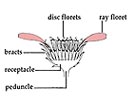

Cypsela
An achene with a thin leathery pericarp and a parachute-like pappus."The Transvaal Daisy is grown for its colourful flowers and clumping habit. It is planted in small or cottage gardens along borders or used in rockeries. It is also grown in pots or mass planted as a ground cover. It establishes in one season from division and is suitable for coastal or inland regions. The flowers are used in floral arrangements and will last up to 10 days. They are grown best in raised beds to ensure good drainage and the plant collapses in wet soils.
When watering during summer, avoid wetting the foliage as this encourages fungal diseases, and when pruning remove spent flowers or damaged and disease leaves.
Note:
This plant is susceptible to the Western Flower Thrips, Cucumber Mosaic Virus (Marmor cucumeris), Powdery Mildew, Crown Rot (Phytophthora nicotianae) and Grey Mold. It is moderately deer resistant.
Sow fresh seed during spring and maintain a temperature of 16º to 18º C. Division of the clump during winter. Remove damaged or disease, foliage and replant with the crown 20 mm (¾ in) above the soil and keep moist.
Propagation by Seed (General)
Germination
In order for a seed to germinate it must fulfil three conditions.
1. The embryo must be alive (a viable seed).
2. The seed must have no dormancy-inducing physiological, physical or chemical barrier to germination; also the seed must be nondormant.
3. The seed must have the appropriate environmental requirements, water, temperature and oxygen.
The interaction between these requirements and dormancy is complex and may lead to different environmental requirements that avoid the dormancy of a seed.
Sowing Seeds in Containers
There are two general methods for germinating seeds.
1. Sowing seeds in a flat or germinating bed, through which seedlings are pricked-out then, transplanted into another flat with wider spacing or directly to an individual pot.
2. Sowing seeds by placing them in to flats with the appropriate spacing or into individual pots.
This method is normally carried out with medium to large seeds such as woody plants and plants that are difficult to transplant.
Seedling production normally occurs in a greenhouse / glasshouse, cold frames and on hot beds.
Method of Seed Sowing
Fine seed is sown in pots or flats that are no deeper than 70 to 80 mm. using a sterilised well-drained media (soil). Fill the container to 20 mm from the top and sprinkle sieved peat to 3 mm depth.
Press the media down level and firm with a piece of timber and then thoroughly moisten.
Mix the fine seed with washed sand and then sow thinly on the surface. These may be lightly covered with sand.
Larger seeds may be covered with media or a hole is dibbled and the seed is placed in the media.
Watering Methods
For watering you may either mist the containers from above or place the container in tepid water and allow the water to raise through the pot to the surface of the media, then drain away and do not fill to the top of the container.
Place a piece of glass over the pot and store in a protected warm environment (glasshouse).
Seeds germinate best in darkness so shade the containers if in direct sunlight.
After the seedlings have sprouted remove the glass and ease the seedlings into direct light.
When the seedlings are large enough prick them out and transplant into larger containers then place them in a shade house to harden off.
Many seeds have different methods of seed preparation for germination such as nicking or cutting the seed coat to allow water penetration, also placing seeds in hot water and allowing it to cool off.
This is particularly important as it is softening the seed coat.
Crown Division
The crown is the part of the plant at the surface of the soil where new shoots arise. With lateral shoots the crown of some plants requires division when they become crowded.
PEST
NAME
Aphids
Various Aphid Species
ORDER
Hemiptera
FAMILY
Aphididae
Description of the Pest
The common name varies and aphids may be referred to as black fly, greenfly, ant cows or plant lice.
These small insects have soft globular body that is from 1mm to 8mm long and vary in colour from green, yellow, black and pink, with the winged forms being elongated. Both adult and nymphs, have piercing and sucking mouthparts.
Aphids are found on buds, flowers, or leaves and stems, preferring soft new growth. On older leaves the aphids are found in protected positions, such as under the leaf. Certain species of aphids form galls as they suck sap and may be found on the roots of the plant. (E.g. Woolly aphids and Black peach aphids)
Most aphids possess a pair of characteristic tubular projections, known as cornicles; these secrete a pheromone and a waxy fluid, which is thought to protect them from some of their predacious enemies.
White exoskeletons, honey dew and sooty mould indicate the presence of Aphids
Balsam Twig Aphid (Mindarus abietinus) is greenish and covered in a white wax and is normally found on the young shoots of conifers bending and killing the needles. It is found on Abies and Picea species.
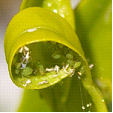 Aphid and their exoskeletons
Aphid and their exoskeletons 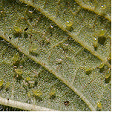 on underside of a leaf
on underside of a leaf
Black Citrus Aphid (Toxoptera aurantii) has a soft plump green body and the black coloured adults may or may not be winged. They feed in groups, curling leaves and producing honeydew attracting sooty mould.
Green Peach Aphid (Myzus persicae) is a soft plump green insect up to 0.2mm long and may be wingless. The nymphs are yellowish green and are responsible for spreading viruses in Dianthus species.
Spruce Gall Aphid (Chermes abietis) form cone shaped galls up to 12mm long resulting from the feeding. The wingless female adult lays eggs on the stems and the immature females overwinter on bud scales. Large infestation will weaken trees such as Picea abies and Pseudotsuga menziesii.
Tulip Bulb Aphid (Anuraphis tulipae) is small, waxy grey coloured and infests the underside of the bulb scales or rhizomes. They occur in the ground or on above ground parts and during storage.
Life Cycle
These insects have a Hemimetabolous life cycle, i.e. The nymphs resemble the adults.
During spring all eggs produced hatch as female nymphs. Adult Aphids are capable reproducing without fertilisation. The males are only produced in some species as the weather cools down, and the day length shortens.
Aphids are capable of giving birth to living young and large populations build up quickly during summer. Over crowding causes the aphids to become smaller, less fertile and produce more winged forms that can migrate to other host plants.
There are many different types of aphids and the life cycle varies from warm to cold climates.
Typical life cycles

Distribution of the Pest
World wide
Period of Activity
In warm climates they are seen throughout the year, but aphids dislike hot dry or cold conditions and heavy rain will decrease the population. In cold areas aphid eggs are laid around a bud base or other protected areas of the plant during autumn and emerge as nymphs during spring, feeding on the new growth.
Numbers build up quickly in the warmer months of the year. Some species feed during winter on Sow thistles.
Susceptible Plants
There is a wide range of plants attacked, from roses to vegetables, shrubs and trees. Certain aphids attack a specific genus while others have a wide range of host plants. Many are capable of transmitting plant virus diseases.
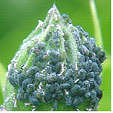 Adults and nymphs feeding
Adults and nymphs feeding 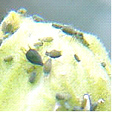 A colony of aphids
A colony of aphids
Acer species are attacked by several aphids including the Norway Maple Aphid (Periphyllus lyropictus) which is a greenish with brown markings and secret honeydew, preferring Acer platanoides. Other aphids include (Drepanaphis acerifolia) and (Periphyllus aceris) which are commonly found on the underside of leaves.
Acer species are also attacked by the Woolly Maple Aphid (Phenacoccus acericola) which covers the undersides of the leaves with a cotton-like mass
Alnus species are infested with the Alder Blight Aphid (Prociphilus tessellates) which is blue-black adult that forms woolly masses on the down-turned leaves. The nymphs overwinter in bark crevices.
Aquilegia species are attacked by several aphids including (Pergandeidia trirhoda) which is a small, flat cream coloured insect that is found on young branches and the underside of leaves.
Betula species may be attacked by the European Birch Aphid (Euceraphis betulae) which is small and yellowish or the Common Birch Aphid (Calaphis betulaecolens) which is large and green producing ample honeydew for sooty mold to grow on.
Callistephus species may be attacked by the Corn Root Aphid (Anuraphis maidi-radicis) causing the plant to become stunted, the leaves wilt and turn yellow. The aphids feed on the roots producing honeydew and are dispersed to other host by ants. It is also attacked by the Potato Aphid (Macrosiphum solanifolii).
Carya species are attacked by Gall Aphids (Phylloxera caryaecaulis) which is found on the leaves, twigs and stems forming galls and turning them black.
Chaenomeles and Gladiolus species, new growth and leaves become infested with the aphid (Aphis Gossypii)
Cupressus macrocarpa may become infested with the Cypress Aphid (Siphonartrophia cupressi).
Cyclamen species are attacked by the aphid (Myzus circumflexus) and (Aphis gossypii) which can infest healthy plants.
Dendranthema, Dianthus and Crocus species are attacked by several types of aphid including the Green Peach Aphid (Myzus persicae) and the Chrysanthemum Aphid (Macrosiphoniella sanborni).
Hibiscus species are attacked by the aphids (Aphis craccivora) and (Aphis gossypii), both congregate towards the branch tips and may cause leaf curl. Normally only seen in sub-tropical climates.
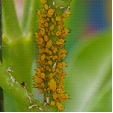 Aphids on a stem
Aphids on a stem 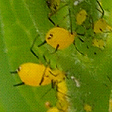 Mandevilla species
Mandevilla species
Larix species is attacked by the Woolly Larch Aphid (Adelges strobilobius). The winged adults deposit eggs at the base of the needles during spring and white woolly areas appear attached to the needles where the adult aphids feed. The young aphids overwinter in the crevices of the bark.
Mandevilla species is attacked by aphids that congregate towards the branch tips and may cause leaf curl.
Pinus species is attacked by several species of aphid including Pine Bark Aphid (Pineus strobi), Pine leaf Aphid (Pineus pinifoliae) and the White Pine Aphid (Cinara strobi).
Primula species are attacked by four species of aphid including foxglove, and green peach aphid.
Rudbeckia, Delphinium, Chrysanthemum and Helianthus species are attacked by a bright red aphid (Macrosiphum rudbeckiae).
Sorbus aucuparia is affected by the Rosy Apple and Woolly Apple aphid which attacked the foliage and young shoots.
Spiraea species are attacked by the Aphid (Aphis spiraecola) which feeds on the young shoots and flowers.
Tropaeolum species are attacked by the Black Bean Aphid (Aphis fabae), which is found in large numbers on the underside of the leaves, turning them yellow and causing them to wilt then die.
Tulipa, Iris, Freesia, Gladiolus and Zephyranthes species are infested with the Tulip Bulb Aphid.
Ulmus species are infected by two types the Woolly Apple Aphid (Eriosoma lanigerum), which curls and kills young terminal leaves and the Elm Leaf-Curl Aphid (Eriosoma ulmi) which occasionally attacks the trees.
Viburnum species are attacked by the Snowball Aphid (Anuraphis viburnicola). This aphid congregates at the end of the branches causing the leaves to curl and become deformed under which they hide.
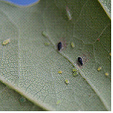 Aphids on Quercus robur
Aphids on Quercus robur
Damage Caused
Buds that have been attacked may not open, leaves and twigs become twisted or distorted and wilt. The aphids also produce honeydew, which is sticky and attracts sooty mould (fungus). This fungus forms a thick layer over the leaf, fruit or stems reducing the plants photosynthesis capability. The sooty mould spoils the plants appearance and its fruit, as does the insects white exoskeletons.
Control
Cultural Control
Aphids may be removed from a plant by hosing them off with water (limited success) or applying soapy water to aphids.. Another organic sprays can be efficient in controlling aphids. Aphids may also be removed physically by hand for small colonies on spine less plants. Species that live under ground are difficult to control but cultivation of the surrounding soil may help in controlling the infestation. (limited mainly to annual or commercial crops)
Reflective mulch around the plants also reduces numbers by repelling the insect this material is available commercially. (Reflective mulches are mainly used in market gardens for avoiding the Green peach Aphids) Resistant rootstocks are available to avoid some root feeding aphid of commercial plants, e.g. Vines and fruit trees
Biological control
Aphids are attacked by several insects includes parasitic wasps or predators such as ladybirds/ lady beetles, hover flies, lacewings, spiders.
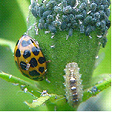
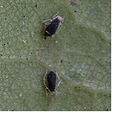 Parasitised aphids
Parasitised aphids
Chemical Control
Aphids may be controlled by spraying with a contact or systemic insecticide. The type of application used will depend on the plant is being attacked.
Aphids can be suffocated and therefore controlled with the use of e.g. White oil, Pest oil, Soapy water from soap such as Lux Flakes ®
Note
It is your responsibility by law to read & follow the directions on the label of any pesticide
Monitoring
Aphid are attracted by yellow colour and traps such as boards painted yellow and covered in glue or sticky substance will attract and trap the insects. There is also a commercially sticky yellow tape that can be attached to susceptible plants
Amendments by B. Sonsie Dip Hort Sc Burnley
PEST
NAME
Cyclamen Mite
Phytonemus pallidus
ORDER
Acarina
Description of the Pest
This tiny eight-legged mite grows up to 0.2mm in length and not normally seen with the naked eye and has rasping mouth parts. Females lay many eggs, which hatch and reach maturity within ten days in the warmer months. Immature nymphs are simular to the adults. The microscopic mite has a gradual metamorphosis.
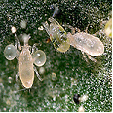
Appearance of the Pest
They congregate in the leaf, flower buds and stored cyclamen corms, during winter. In spring, they migrate back into the buds and leaves. Mites may spread via the movement of dead leaves, buds or corms. They initially appear in leaf and flower buds.
Period of Activity
Most active during hot humid periods, especially in tropical to temperate regions, where the insect may remain active throughout the year.
Susceptible Plants
There are many susceptible plant including Rhododendron, Begonia, Fuchsia, Cyclamen, Pelargonium,Gerbera, Saintpaulia, Hedera and Dieffenbachia species.
Damage Caused
The flower buds may weather and fall prematurely or the flowers that open may be spotted or discoloured. The mites also congregate under mature leaves causing them to curl or pucker. The leaves become mottled, yellow and are eventually shed.
Control
This pest is distributed world-wide. Remove infested buds and leaves and destroy. Preventive measures include weed control and removal and destruction of crop residue infested plant material. Natural predators include ladybeetles and lacewing larvae help reduce numbers.
Chemical Control
Affected plants can be sprayed using contact or systemic insecticides. The mites are well protected in the buds and may be difficult to kill.
Note
Always read the label for registration details and direction of use prior to application of any chemicals.
PEST
NAME
Western Flower Thrips
Frankliniella occidentalis
ORDER
Thysanoptera
FAMILY
Thripidae
Description of the Pest
Adults are tiny (1mm) long cigar-shaped insects with banded abdomens, and two pairs of feathery wings. Nymphs have yellow bodies. Adults and nymphs have rasping and sucking mouth parts.
Appearance and Distribution of the Pest
Found throughout Australia.
Life Cycle
This insect has a Hemimetabolous life cycle, ie. When the immature nymphs resemble the adults.
Later (non-feeding) nymphal stages occur in leaf litter or surrounding soil. Adults mature in a fortnight under ideal conditions; they may survive for six weeks and produce up to 300 eggs over this period. Many generations appear each year.
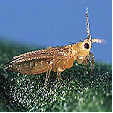
Period of Activity
Most active during warmer dry months
Damage Caused
Adults and nymphs feed on plant tissue of flowers, shoots and fruit. Flowers develop silvery discoloration; shoots and fruit may become deformed. Eggs are also laid in the plant tissue, causing further physical damage and making the plant susceptible to wilt.
Susceptible Plants
A wide range of flowering and fruiting plants, both native and exotic, including Dendranthema, Gerbera, Gypsophila, Rosa, Fragaria, Lactuca, Lycopersicon, Cucumis and Vicia species are attacked.
Cultural Control
No effective control.
Biological Control
No effective control.
Chemical Control
Wester flower thrips are resistant to many insecticides and only the adult and lava stage is susceptible to insecticides such as Omethoate or Maldison. Consult your agricultural authority for current advice.
Note
Always read the label for registration details and direction of use prior to application of any chemicals.
Note: Plants affected by this pest are Deer Resistant plants not the susceptible plants.
PEST
NAME
Deer
Cervus species
ORDER
Artiodactyla
FAMILY
Cervidae

Description of the Pest
There are two species of the deer in North America, the Whitetail (Odocoileus virginianus) and the Mule deer (Odocoileus hemionus) with several regional variations such as the Pacific coastal Blacktail (O.h. columbianus) which is regarded as a sub-species of the Mule deer.
The Whitetail on average grows to 112 cm (44in) tall and 180 mm (70 in) long and weigh 68 kgs (150lbs). The fir colour varies according to its environment but generally it is reddish-brown during summer and grey-brown in winter with a pure white underside on its tail. When the tail is erect it is known as the "white flag". Its antlers consist of two main beams from which the points emerge.
The Mule deer grow to 105 cm (42 in) tall and are up to 200 cm (80 in) long with the adult buck weighing up to 137 kgs (300 lbs) and the does up to 80 kgs (175 lbs). The fir is generally tawny brown during summer and during winter it has a heaver grey-brown to blue-grey coat with a small white tail that is tipped in black. The other distinguishing features are its ears that are up to 300 mm (1 ft) long (mule-like) and its antlers, with the two beams that are forked into smaller beams, which inturn fork again and again.
The Blacktail deer (Pacific coastal Blacktail) grows to 97 cm (38 in) tall and is up to 105 cm (60 in) long and weighs on average 73 kgs (160 lbs). The fir is generally tawny brown during summer and during winter it has a heaver grey-brown to blue-grey coat with a tail that is dark brown at the base then changing to black for 50% of its length. The antlers consist of two beams that are forked into smaller beams, which inturn fork again and again.
Appearance and Distribution of the Pest
The Whitetail deer are found throughout eastern United States, on the coast and inland but are not commonly seen in California, Utah or Nevada. They do not migrate but congregate together (yard up) during winter and feed in a part of their existing territory.
The Mule Deer are found in the western part of North America from South eastern Alaska to Mexico and from the Pacific coast to Texas. They migrate from highland mountain meadows to southern or lower snow free forested valleys during winter.
The Blacktail deer are found on the Pacific coast from Alaska to northern California. There is both resident and migratory Blacktails. The migratory Blacktails move southwards during late autumn at the first sigh of snow or heavy sustained rain and the resident Blacktails seek cover their existing territory amongst woodlands during the winter months.
Life Cycle
All Deer breed from autumn to early winter and the does give birth from late spring to early summer.
Period of Activity
Deer are most active from spring to autumn but can be troublesome during winter when the feed is scarce. In some regions urban landscapes become the major food source both in summer and winter.
Damage Caused
Browsing deer will feed on almost any plant and is most commonly noticeable during spring feeding on the new growth or twigs and stems leaving a shredded appearance. Deer also rub their antlers against trees damaging bark and snapping off small branches, this action also incurs damage under hoof as plants, lawns and garden structures are trampled on.
Susceptible Plants
Some plants are more palatable to deer but when a deer is hungry or during drought conditions there are no "Deer Proof" plants. There is a range of plants that have a bad taste and are not destroyed and are regarded as (deer resistant plants). Deer resistant plants are the plants that are attached to this file not the susceptible plants.
Cultural Control
There are many cultural controls that have been tried to move browsing deer such as frightening them with strobe lights, pyrotechnics or tethered savage dogs. These actions are only temporary and may cause more trouble as the stampeding animals move off. Fencing and netting can be an effective method of discouraging hungry deer from gardens but may be expensive on a large scale and require maintenance. There are several types of fences which include conventional 2.2m (8 ft) deer-proof woven wire fences or single-wire electric fences and slanted deer fences. Plant selection can also be effective, by using less desirable plants (deer resistant plants) as an outer border to the more desirable plant species and thus discouraging the deer to enter the garden. Hedges and windrows of less desirable thorny plants can also be a deterrent to browsing deer.
Chemical Control
There are two main types of repellents contact and area. Contact repellents are applied directly to the plants and deter deer with a bad taste or smell. They can be applied by rubbing or spraying on to the plants and commonly used in an egg mixture. The commercial products have proven to work better than home remedies which include soap or chilli mixtures and hanging bags of human hair.
Area repellents rely on an offensive odour and are placed around areas that are frequently visited.
Contact your local distributor for available types and application.
DISEASE
NAME
Rust (General)
Various Rust Species
Description
Generally this fungal problem involves many species causing a range of symptoms, but generally produces pustules that release reddish - brown spores. Most fungus is specific to its host and normally will not infect other plant species.
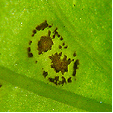 Pustules
Pustules
Symptoms
The upper leaf surface develops red, brown or yellow areas and the underside produces bright yellow to orange spores that correspond to the patches above. Infested leaves become brown in patches, fall prematurely and flower and fruit may also be infected. This overall, results in a loss of vigour and in small plants may lead to death.
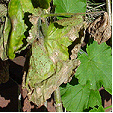 Pelargonium x hortorum
Pelargonium x hortorum
Myrtle Rust (Puccinia psidii) This fungal disease infects plants in the Myrtaceae family and was only recently detected in 2010 and has since spread across eastern Australia from the Northern Territory to Queensland, NSW, Victoria and Tasmania. This rust attacks soft and actively growing foliage or shoots with varying symptoms. It normally starts as small purple spots on the leaves from which spores form in yellow pustules that fade to grey as the infection matures and can merge creating leaf distortion and death of the plant.
The life cycle starts when the powdery yellow spores are distributed by wind to other plants where they germinate and start to grow by piercing the plant cells to obtain nutrients. Germination occurs in dark moist positions with a temperature between 15° to 25°C and the new pustules can release spores in 10 to 12 days, (spores remain viable for 3-months). The spores spread rapidly by wind, water, insects or animals. They are also distributed by plant material, clothing, shoes and vehicles.
 Puccinia psidii
Puccinia psidii
Needle Rust (Melampsora farlowii) infects the new leaves turning them to yellow and fall from the shoot giving the branch a scorched appearance. The fruiting bodies are found on the underside of the leaf and is waxy-red.
Rust in Poplar (Melampsora species). A fungal problem involving at least two species (Melampsora medusae) and (Melampsora larici-idaei).
The upper leaf surface becomes flecked with yellow to light green and the underside produces bright yellow orange spores that correspond to the patches above. Infested leaves become brown in patches, fall prematurely and shoots may die back as a result of not being hardened off to the elements. This overall, results in a loss of vigour and in small plants may lead to death.
The source of the fungus is from other infected plants or fallen leaves and is dispersed by wind.
Host plants include Lombardy Poplars particularly Populus nigra 'Italica' and cottonwoods.
White Rust (Albugo candida) forms snow white pustules that contain colourless spores that turn yellow then brown and are found on the underside of leaves.
White Pine Blister Rust (WPBR) is caused by the fungus (Cronartium ribicola). It is a obligate parasite requiring a living host to survive. The life cycle requires two host species with part of it life on the Pinus species and the other part on Ribes species. First cankers or sores appear on the Pinus species realising spores that land on the Ribes species infecting it. The infection produces a different type of spore that land on the needles and growing branches of the Pinus species and eventually forming cankers. The spores are spread by wind and prefer cool moist conditions. Symptoms include brown spots on the needles and the appearance of dead branches in the crown. Cankers will also appear on the trunk and it tends to attack young trees. Control methods include removal of Ribus species in the affected areas and breading naturally resistant Pinus species.
The Rust (Endophyllum sempervivi) affects Sempervivum species by infecting the young leaves and eventually the crown. The mycelium then travels to the roots and extends into any off shots. Leaves that are infected turn yellowish, grow longer and are thin. Persistent infection may kill the plant.
Source and Dispersal
The source of the fungus is from other infected plants or fallen leaves that contain the fruiting bodies and is dispersed by wind.
Favoured Conditions
Generally rust is more prevalent during summer, preferring warm humid conditions and particularly when the leaves are damp.
Affected Plants
A wide range of ornamental annuals, perennials, ferns, trees, shrubs including, Hibiscus species that are infected by Kuehneola malvicola predominantly in southern USA.
Abies species are infected by many types of rust including (Milesia fructuosa) and (Uredinopsis mirabilis).
Abutilon, Phymosia and Alcea species are infected by the rust (Puccinia heterospora).
Alnus species are occasionally infected with Leaf Rust (Melampsoridium hiratsukanum) which forms yellowish pustules on the leaves that develop turning the leaf brown.
Amelanchler species and Calocedrus decurrens are infected by several rust species including (Gymnosporangium libocedri).
Antirrhinum majus (Snapdragon) is infected by the rust (Puccinia antirrhini). This fungal problem that infects the epidermal layer on the leaf underside, forming pale green areas that are raised and split open revealing reddish brown spores that have a dusty appearance.
As the infestation grows, concentric rings of spore pustules appear around the original infection. The corresponding position on the upper leafs surface turns yellow eventually causing the leaf to wilt and die. The infestation is not restricted to the leaves; all above ground parts of the plant are susceptible and infected plants transmit the fungus dispersing it by wind.
Infected plants should be removed and destroyed.
Anemone and Prunus species are infected by the rust (Tranzschelia pruni-spinosae) that stimulates abnormal growth in the plant during spring.
Aquilegia, Anemone, Delphinium and Clematis species are infected by the Rust (Puccinia rubigo-vera var. agropyri).
Arctostaphylos manzanita is infected by the rust (Pucciniastrum sparsum) occurring in coastal regions but is not normally detrimental to the plant.
Artemisia species are infected by the rust (Uromyces ari-triphylli) which is a systemic disease that is transmitted through seeds. It causes the leaves to turn yellow then die and can infect all parts of the plant except the roots.
Bambusa species are infected by the rust (Dasturella divina) which forms elongated brownish strips on the leaves.
Berberis species may be infected by the Rust (Puccinia graminis) that forms orange spotting on the leaves. It certain regions plants infected with this rust must be removed and destroyed to avoid infecting neighbouring agriculture crops.
Betula species may be infected by Leaf Rust (Melampsoridium betulinum) that forms reddish-yellow spots on the leaves and heavy infestation can defoliate the tree. The host tree changes to Pseudolarix species during the sexual stage and causes blistering of the leaves.
Calendula species may be infected by the Rust (Puccinia flaveriae).
Callistephus and Solidago species may be infected by the Rust (Coleosporium solidaginis) which forms bright yellow spots particularly on new foliage or young plants.
Canna species may be infected by the rust (Puccinia Thaliae).
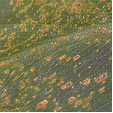
 Canna indica
Canna indica
Centaurea species are infected by the rust (Puccinia cyani) and (Puccinia irrequisita) which can cover the stems and leaves.
Cleome species are infected by the rust (Puccinia aristidae) but rarely requires control.
Dianthus species are infected by the rust (Uromyces dianthi) which forms powdery brown spots that appear on both sides of the leaves. The leaves curl and die and the plant becomes stunted. This is a common problem that occurs when grown in a protected enclosure (hot house).
Ficus species are infected by the rust (Cerotelium fici) which forms small brown spots, and causes the leaves to turn yellow then fall prematurely.
Fuchsia species are infected with (Pucciniastrum epilobii). This fungus caused purplish red blotches on the upper leaf surface, that become dry in the middle and result in a brown patch with purple edges. On the underside of the leaf, corresponding to the patches, yellow orange spores form. Heavily infected leaves become yellow and drop prematurely. This leads to a loss of vigour in the plant and infected plants transmit the fungus.
Certain cultivars are more susceptible than others, particularly 'Orange Drops' and 'Novella'.
Hydrangea species is infected by (Pucciniastrum hydrangeae) causing yellowish brown pustules to appear on both sides of the leaf. The leaf becomes dry and brittle.
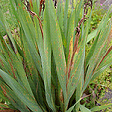
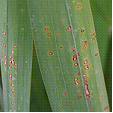 Iris species
Iris species
Iris and Dietes species are very susceptible to the rust (Puccinia iridis). Leaves form rusty red powdery spots that enlarge. They are appear on both sides of the leaves causing the surrounding area to turn pale yellow then brown and the black spores appear soon after, overwintering on dead infected leaves. Plants may be heavily infected but normally survive attack.
Larix species are infected by several Needle Rusts including (Melampsora paradoxa), (Melampsora medusae) and (Melampsoridium betulinum). The fungi attacks the needles predominantly towards the branch tips turning them yellow and eventually killing them . The underside of the leaf develops pale yellow fruiting bodies.
Lupinus species are infected by three species of rust including (Puccinia andropogonis var onobrychidis).
Malus andChaenomeles species may be infected by the rust (Gymnosporangium juniperi-virginianae) or (Gymnosporangium clavipes) which forms brown or bright orange spots on the leaves or twigs and can defoliate the tree. Juniperus virginiana and Mespilus germanica may also be infected by rust.
Mathiola and Arabis species are infected by White Rust.
Pinus species are infects by the Comandra Blister-rust (Cronartium comandre).
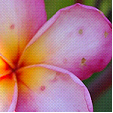
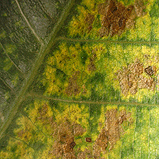
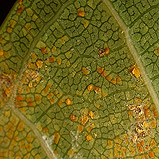
Plumeria rubra Leaf upper surface Leaf underside
Plumeria species are susceptible to the rust (Coleosporium plumeriae). Leaves and flowers may be infected with the underside forming bright yellow pustules and causes premature leaf or flower drop.
Populus nigra 'Italica' is infected by the rust (Melampsora species) which forms pustules to form on the leaves turning them brown and causing premature leaf drop.
Rhododendron and Tsuga species are infected by the rust (Pucciniastrum vaccinii) and is commonly found in nursery stock, spreading rapidly. Tsuga species are also infected by Needle Rust.
Ribes species are infected by the rust (Cronartium ribicola). This leaf rust appears on the underside of the leaves (preferably older leaves) forming dusty brown pustules and is a serious problem. This rust only appears when White Pine (Pinus strobes) grows near where the alternate stage of the fungus occurs.
Rudbeckia species are infected by several species of rust including (Puccinia dioicae) and (Uromyces rudbeckiae).
Salix species are infected by four types of (Melampsora species).
Senecio, Bellis and Calendula species are infected by the rust (Puccinia lagenophora) which forms blister-like pustules that release brown spores.
Sorbus aucuparia is affected by several rust from the (Gymnosporangium species) causing circular yellow spots, that appear on the leaves during summer and develop into orange cup-shaped fruiting bodies.
Trillium species are infected by the rust (Uromyces halstedii) that damages the leaf surface.
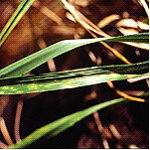 Festuca arundinacea
Festuca arundinacea 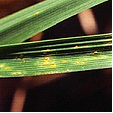 Rust
Rust
Turf Grass are susceptible to rust (Puccinia species) and (Uromyces species), causing yellow flecks to appear on the stems and leaves. These markings enlarge before the pustules form and in severs cases the lawn has a yellow, red or brown appearance.
The infection appears from spring to summer under humid low light conditions and turf that is under stress or with excessive nitrogen in the soil is more susceptible. Many species may be infected including Lolium perenne (Perennial Ryegrass) and Poa pratensis (Kentucky Bluegrass).

 Rust on Perennial Ryegrass
Rust on Perennial Ryegrass
Viburnum species are mildly affected by two types of rust (Coleosporium viburni) and (Puccinia linkii).
Viola species are infected by the rust (Puccinia violae) which forms green spots on the underside of the leaves. It is not commonly seen on cultivated plants.
Non-chemical Control
Cut off and destroy any infected branches, fallen leaves and remove heavily infected plants. Improve the culture by, pruning to improve air circulation, allow space between plants and avoid over crowding. Avoid planting susceptible species. Plants that are infected with a systemic form should be removed and destroyed
Chemical Control
Not possible to spray large trees but young plants may be treated with a protectant fungicide such as wettable sulphur. In a domestic garden small plants such as Fuchsia species may be sprayed with a protectant chemicals as symptoms appear, aided by the removal of existing infected leaves. Under commercial conditions stock may be sprayed with a fungicide such as oxycarboxin.
Note
Always read the label for registration details and direction of use prior to application of any chemicals.
DISEASE
NAME
Spotted Wilt Virus
Various Spotted Wilt Virus
Description
Viral problem that infects the leaves and stems of many plants.
Symptoms
Spotted Wilt Virus is a systemic disease that attacks a variety of plants with variable symptoms. In tomatoes young plants are particularly venerable, as indefinite mottling or rings first form on the upper surface of young leaves, eventually covering the leaf, causing it to shrivel and die. Stems and petioles or peduncles develop brownish streaks as the virus spreads eventually killing the young plants.
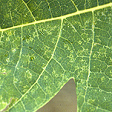 Pawpaw
Pawpaw
Older plants that are attacked produce new foliage that is mottled with bronze colouring which soon turns black causing the leaf to shrivel and die. Stems can also be affected with brown streaks and fruit of an infected plant, ripens unevenly and is marked with circular blotches. This may cause premature fruit fall.
Spotted wilt also causes plants to become stunted and for flowers to develop reddish or yellow rings.
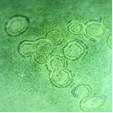 Fruit
Fruit
Source and Dispersal
The virus is found on other infected plants and is spread by thrips, particularly Onion thrips (Thrips tabaci) and Western Flower Thrips (Frankliniella schultzei). The virus may also be dispersed in infected rhizomes or tubers or nursery stock.
Favoured Conditions
Hot dry weather favours thrips activity particularly during summer, spreading the virus which appears 2 to 3 weeks later.
Affected Plants
A wide range of vegetables and ornamentals are attacked include capsicums, potatoes, broad beans and
Amaryllis, Anemone, Antirrhinum, Aster, Begonia, Calceolaria, Calendula, Chrysanthemum, Dahlia, Gerbera, Lactuca, Lathyrus, Lilium, Lycopersicon (Tomato), Nasturtium, Papaver, Pericallis, Petunia, Phlox, Schizanthus and Zinnia species.
All have simular symptoms with yellowish wavy marks that spread causing the leaf to distort turn brown and die.
Other plants such as Zephyranthes species develop yellow or parallel streaks on the leaves that spread to the stems.
Non-chemical Control
Preventative measures are important for the uninfected plants by not planting near tomato crops and the removal of weeds. The controlling of thrip infestations greatly reduces distribution of the virus.
Chemical Control
There is no chemical control of viral problems.
DISEASE
NAME
Grey Mould
Botrytis cinerea, B. elliptica
Description
Grey Mold, Shoot Blight, Petal Blight is a fungus problem that generally forms water-soaked spots that rot and produces greyish sclerotia (fungal resting bodies) on the surface. They can be found throughout the year on dead tissue and on live material during under ideal climatic conditions. Damaged areas such as a tear in a leaf or an opening made by an insect are more likely to be infected.
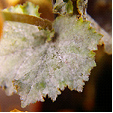 Grey Mold on Begonia species
Grey Mold on Begonia species
Image by B. Sonsie
Symptoms
The fungus attacks stems, leaves, flowers and fruit. In roses the fungus is primarily attacks the flowers producing pink rings on the petals and buds that become brown and rotten. This may extend down the peduncle to the stems causing dieback.
In other plants oval yellowish to brown spots appear, then the centre turns greyish and dries out and in humid weather the spots spread, joining up and infecting the entire leaf. This infection may also occur on the stems, and flowers may form abnormally or brown off and die.
When lettuce is infected it starts at the base causing a soft brown rot that may extend up the stem killing the plant, and pears flowers become infected then spreading to the fruit. This develops a sunken brown area that is soft and eventually is covered in grey powdery spores.
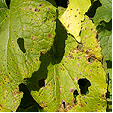
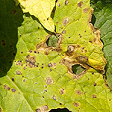 Botrytis Blight on Senecio cruentus
Botrytis Blight on Senecio cruentus
Botrytis Blight (Botrytis tulipae) infects leaves, flowers and stems with flecks of brown spots that merge to form light grey rotted areas that have brownish margin that may destroy stems. Affected areas are covered in a grey mould during humid conditions. The spores overwinter in dark brown sclerotia, which are found on the outer scales of the bulb or at the base of the stem in Tulipa species.
Grey Bulb Rot (Rhizoctonia tuliparum), which infects the bulbs of Tulipa species, attacking the base of the leaves and rotting the bulb. When bulbs emerge during spring in infected soil's they soon die off. The greyish mold tends to be dry.
Source and Dispersal
The sclerotia (fungal resting bodies) are found on dead plant material or in the soil and remain viable for many years. The spores are dispersed by wind or splashing water.
Favoured Conditions
It prefers cool moist climate with morning dew.
Affected Plants
Grey Mold attacks a wide range of plants including roses, fruit trees, pelargonium, ferns, grapes and cyclamens. Heliotropium , Amaryllis, Lilium and Hippeastrum species are also infected.
Agave species are infected by two fungal Leaf Blights (Botrytis cinerea) and (Stagonospora gigantea) that severely damage the leaves particular during wet periods or from excessive watering.
Cactus species are infected by soft rot or Grey Mould (Botrytis cinerea). Stems and pads turn are greyish with the upper surface, rotting then collapsing. The dieing tissue becomes slimy and is covered with grey mould that develops black sclerotia, which propagates the disease. It is more prevalent under warm humid conditions and control methods include removing infected parts and destroying them. In glasshouse situations ventilation should be improved and watering should be restricted to create a drier atmosphere.
Cereus species and other cacti are infected by Grey Mold causing the segments to become discoloured and as the rot progresses it tissue becomes slimy and collapses. Black sclerotia forms on the affected areas that are covered in grey mold during humid conditions.
Cuphea species are infected by this blight.
Orchids such as Cattleya, Cymbidium, Cypripedium, Dendrobium, Epidendrum, Oncidium, Paphiopedilum, Phalaenopsis and Zygopetalum species are infected by Grey Mold or Petal Spot (Botrytis cinerea). Petal and flower stalks form small brown spots.
Paeonia species are infected by Botrytis Blight (Botrytis paeoniae) causing the leaves and flowers to form a grey mold then suddenly collapse and die.
Pseudotsuga menziesii Douglas Fir is infected by Leaf and Twig Blight (Botrytis cinerea). This is a serious problem in wet conditions and is difficult to control.
Ribes species are attacked by Cain Blight (Botryosphaeria dothidea). The infection causes the cains to become blighted and wilt. To control remove damaged wood and destroy.
Non-chemical Control
Remove and destroy infected plants or fallen leaves. When planting, space as to allow good air movement to reduce humidity. Bulbs that are infected should be discarded and take care that bulb scales are removed from the soil to prevent further infection. Cactus and succulents that are infected should have the damaged areas cut out, or discard the entire plant. Under glasshouse conditions improve the ventilation and reduce watering to create a drier atmosphere.
Chemical Control
Under humid conditions spray regularly using a suitable fungicide such as thiram, mancozeb, dichloran and chlorothalonil.
Note
Always read the label for registration details and direction of use prior to application of any chemicals.
DISEASE
NAME
Phytophthora Rot
Phytophthora species
Pathogen Name
A number of Phytophthora species cause these diseases but the most important species in Australia is the cinnamon fungus, Phytophthora cinnamomi. This species is exotic to Australia and probably originated from south east Asia; it has probably been present in Australia for close to 200 years. Phytophthora are fungal-like organisms that are related to some protozoa and algae; they are microscopic and cannot be observed by the naked eye.
Description
There are many types of Phytophthora Rot but generally the disease affects the plant by causing a soft rot of the affected plant part. The most common form of the disease is a rotting of the roots that occurs below ground with no visible symptoms of the disease above ground until the disease starts to cause leaf drop.
Symptoms
The disease is initiated below ground in the soil, usually on the feeder roots of a plant. The pathogen grows through the roots killing cells and eventually causing an extensive root decay. This causes the infected plant to lose vigour and the leaves to yellow and die. Entire branches starting from the top then die, quickly during hot weather or linger for months. The infection occurs on the root hairs causing small and large roots to rot. The symptoms of the disease are often very difficult to differentiate from drought symptoms, mainly because the affected root system prevents the uptake of moisture from the soil. Once the disease has progressed far enough large branches will die causing the typical dieback symptoms.
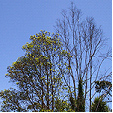
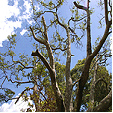
There are a number of other diseases caused by Phytophthora species
Twig Die Back (Phytophthora ilicis) attacks Ilex species causing black leaf spots and black stem cankers.
Phytophthora cactorum is known by several common names depending on which plant is being attacked and they have various symptoms. Plant species are listed below.
Root Rot (Phytophthora richardiae) infects Zantedeschia species causing the leaves to turn yellow, wilt and die. Flowers are deformed if they bloom and the infection can also be seen in the new growth, eventually killing the plant. On inspection the roots show signs of decay.
Stem Rot (Phytophthora cryptogea) infects the roots and stems turning them brown and seeds are also attacked causing decay. It is commonly found on Tagetes erecta and infected plants wilt, collapse and die.
Source and Dispersal
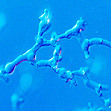 Sporangia
Sporangia 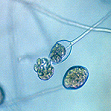 Zoospores
Zoospores 
Image by Dr Brett Summerell
Phytophthora species produce sporangia that contain specialised zoospores that have flagella that allow them to move through the soil moisture small distances. These spores encyst on the root and then penetrate the root. The pathogen also produces chlamydospores, specialised survival spores that allow it to survive in the soil for extended periods of time. The chlamydospores can be transported in soil, even extremely small amounts, allowing the pathogen to be dispersed very easily throughout an area and from one location to another. The zoospores are easily moved in water flowing through soil and so are easily dispersed down slopes. It is not uncommon for the disease to move in fronts down a slope.

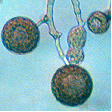 Chlamydospores, specialised survival spores
Chlamydospores, specialised survival spores
Image by Dr Brett Summerell
Favoured Conditions
Phytophthora root rot is favoured by poorly drained soils or in soils that are waterlogged for short periods of time. The disease generally occurs during periods when the temperature is above 16ºC although it has been observed in snow gum country in the Barrington Tops National Park and in southern Tasmania. It also prefers soils that have little organic material.
Affected Plants
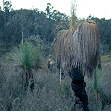
 Xanthorrhoea species
Xanthorrhoea species
Image by Dr Brett Summerell
The host range that is attacked by Phytophthora cinnamomi is enormous and is still not well understood but includes many Australian native plants, Rhododendrons, Acer and Prunus species, conifers, cabbage tree and strawberries. Some Australian plant families that are quite susceptible include species in the Proteaceae, Epacridaceae and Xanthorrhoea species.
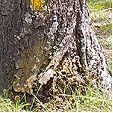 Alphitonia excelsa
Alphitonia excelsa
Alphitonia excelsa can be infected by Phytophthora cinnamomi causing loss of foliage, death of the upper branches and cankers on the trunk.
Cactus such as Cereus species may be infected with Slimy Collar Rot (Phytophthora cactorum) which forms a soft black area at the base of the plant that is water soaked.
Chamaecyparis species may be infected with the Root Rot (Phytophthora lateralis) that attacks roots, trunk, stems and leaves.
Cornus species are infected by Crown Canker (Phytophthora cactorum) and in this case the tree is partially infected initially with one side producing smaller leaves that turn reddish in late summer. The leaves may also shrivel and die prematurely, during dry periods and small and large branches die. After a couple of seasons the tree becomes completely infected with poor top growth and an inconspicuous canker develops at the base of the trunk. Eventually the tree dies.
Erica species are infected by (Phytophthora cinnamomi). The symptoms include foliage turning greyish towards the top, and then the plant wilts then dies with evidence of infection at the base.
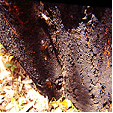 Phytophthora in Eucalyptus species
Phytophthora in Eucalyptus species
Image by B. Sonsie

Image by Dr Brett Summerell
Eucalyptus species are infected by Phytophthora cinnamomi causing rapid die back of the tree with blackened trunk loss or upper growth and is a serious problem for certain species such as Eucalyptus diversicolor (Karri).
Euphorbia pulcherrima is susceptible to Root Rot (Phytophthora and Pythium species). Roots become dark and the rot can extend up the stem. The plant is also susceptible to leaf blight resulting from the same fungal disease.
Hedera species are infected by Phytophthora Blight (Phytophthora palmivora). This fungus causes leaf spots, foliage blight and stem rot.
Palms such as Archontophoenix, Caryota, Chamaedorea, Cocos, Dypsis, Howea, Liculia, Linospadix, Livistona, Phoenix, Ptychosperma, Rhapis, Roystonea, Syagrus, Washingtonia and Wodyetia species are also susceptible to Phytophthora Blight forming large irregular areas on the fronds that become dark and rotten and limited by the veins
Lilium species are infected by Foot Rot (Phytophthora cactorum) which attacking the stems just below the soil level causing the plant to topple and if infection occurs as the leaves are emerging the base of the infected leaves which collapse remain attached to the bulb.
Morinda citrifolia is infected by Phytophthora Blight, black flag disease (Phytophthora species) which causes the foliage to turn black and limp. The fruit and stems are also infected causing them to turn brown-black and whither.
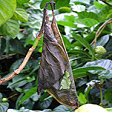
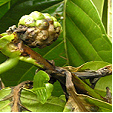 Morinda citrifolia
Morinda citrifolia
Orchids such as Cattleya, Cymbidium, Cypripedium, Dendrobium, Epidendrum, Paphiopedilum, Phalaenopsis and Zygopetalum species are infected by Black Rot (Phytophthora or Pythium species). This causes the leaves, pseudobulbs, rhizomes and roots to form a dark soft rot, normally occurring towards the base of the plant.
Saintpaulia, Dianthus, Gypsophila, Limonium and Anemone species are infected by Root and Crown Rot (Phytophthora nicotianae). This is a fast moving fungus that turns the roots blackish then extends to the crown and petioles causing wet rot of the crown then wilting, eventually killing the plant. When found as Phytophthora Leaf Spot or Blight, angular spots appear with water-soaked margins as in Cordyline and Philodendron species.
Sedum species can be infected by up to three Stem Rot fungi including (Colletotrichum species), (Phytophthora species) and (Pellicularia filamentosa). Commonly occurring in wet soils.
Ulmus and Acer species are also infected by (Phytophthora cactorum) and this is known as Bleeding Canker. This casual disease initially causes cankers in the bark that ooze sap and the sapwood forms reddish lesions with greenish margins. The leaves on affected branches turn yellow, wilt then die and mildly affected trees may survive.
Many species are infected by the Bleeding Canker including Acer platanoides, Acer rubrum, Acer pseudoplatanus, Acer saccharinum, Betula species, Liquidambar styraciflua, Aesculus x carnea, Tilia, Salix and Quercus species.
Non-chemical Control
The most effective control for all Phytophthora diseases is prevention primarily because it is extremely difficult to control Phytophthora diseases after they are established in the plant. As Phytophthora species are most easily transported in infested soil quarantine is an essential component of control of the disease and it is for this reason many areas have hygiene protocols to stop the pathogen being introduced into an area. It is recommended that bush walkers take care not to introduce the pathogen on their boots into un-infested areas and for this reason it is suggested that walking boots be cleaned and preferably sterilised (with 70% methylated spirits) prior to starting a walk.
Cultural techniques such as cultivating the soil regularly with added animal manure and other organic substrates to ensure there is good drainage will also help to minimise the impact of the disease. The plants can be mulched with straw or other organic material taking care that the base of the trunk is left clear. Avoid over watering the soil and observe hygiene in regards to tools, containers or shoes to reduce spreading the infection.
Potting mixes should be pasteurised for 30min at 60ºC to ensure that they are free of the pathogen. It is also very important to grow pots off the ground to prevent the splash of infested mix or water from an infected plant to clean plants.
.
Avoid damaging the bark particularly at ground level and seal any wounds that occur. If cactus or tree species are infected it is possible to cut out the infected area when first seen in order to contain it. Correct tree surgery techniques are required for large trees.
Chemical Control
There are a number of fungicides that are registered for use in the control of these diseases. The most effective chemical control are based on the use of chemicals containing potassium phosphonate. This chemical effectively enhances the defence systems of the plant and has been shown to be most effective in controlling Phytophthora diseases. It is essential that the chemical be applied when the plants is exporting nutrients to the roots, so this is best in the warmer months. The chemical can be applied as a stem injection or a foliar spray, and in some situations as a soil drench. There are specialised stem injecting equipment available for stem injections on larger trees.
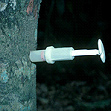
Image by Dr Brett Summerell
Note
Always read the label for registration details and direction of use prior to application of any chemicals.
Amendments by
Dr Brett Summerell
Director Science and Public Programs
Royal Botanic Gardens Trust, Sydney
DISEASE
NAME
Powdery Mildew
Various Powdery Mildew Species
Description
Powdery mildew covers arrange of fungal infections most with simular characteristics of white powdery areas appearing on the leaves and flowers.
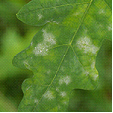
 White powdery area
White powdery area 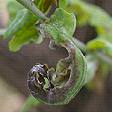
Symptoms
Powdery mildew (Oidium species) affects the following five plant groups with slightly different characteristics.
Cucurbits firstly form white spots on the underside of the leaves. Under optimum conditions the fungus spreads to the upper surface covering the entire leaf causing it to die. It may also extend to the stems slowing the growth of the plant and may reduce the size of the fruit.
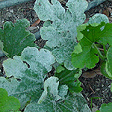
Grape leaves, flowers and fruit are attacked with the appearance of greyish-white powdery spots. Infected flowers set poor quality fruit and infected fruit splits open and dries out.
Pawpaw leaves become infected on the underside at first then spreading covering the entire leaf. The fruit forms irregular light grey spotted areas that damages the surface and under the surface causing the fruit to misshapen and reducing its market value.
Rose leaf and buds are covered in a fine white powdery coating and in severe cases it extends to the stems. When young leaves are infected they become distorted and older leaves develop blackened areas. Infected flower buds may fail to open and opened blooms may be discoloured or distorted.
Strawberries show different signs of infection with the leaf margins first rolling upwards then developing purplish irregular blotches along the veins. The infected flowers may fail to set fruit and if fruit is produced it is small, hard fails to ripen. Semi mature fruit that is infected has dull appearance and may form cracks or split open.
The Powdery Mildew (Sphaerotheca lanestris) infects leaves and twigs. The under side if the leaf firstly has a white mealy growth that matures to felt-like brown mycelium that can cover the entire leaf, and the twig tips. It is only one of the many types that infect Quercus species.
Source and Dispersal
The spores overwinter in fallen leaves, dormant buds, seed and infested plants. It is dispersed by wind.
Favoured Conditions
Generally it prefers warm humid conditions, but failing to germinate when it is raining. The fungus that attacks Pawpaw prefers cooler conditions disappearing in the warmer months.
Affected Plants
There are many plant species ornamental trees and shrubs that are attacked by Oidium species including; Roses, African Violets, Cucurbits, Grapes, Pawpaw, Strawberries, Hydrangeas, Ajugas, Antirrhinum, Oaks and Photinias.
Acer species are infected by the powdery mildews (Uncinula circinata) and (Phyllactinia corylea) but are not normally serious.
Aesculus species are infected by the powdery mildew (Uncinula flexuosa) which forms a white mold on the underside of the leaves.
Arenaria,Cuphea, Erica and Eschscholtzia species are infected by the powdery mildew (Erysiphe polygoni). This fungus is greyish or white and covers leaves or young shoots. Heavenly infected leaves turn brown and fall from the plant. The plant eventually dies.
Aster species are infected with the powdery mildew (Erysiphe cichoracearum) which is more prevalent on the lower part of the plant.
Ceanothus, Corylus, Platanus, Syringa and Weigela species are infected by the powdery mildew (Microsphaera alni) particularly London Plane. The mycelium forms a felt-like cover on the leaves.
Celtis species are susceptible to the powdery mildew (Uncinula parvula) and (Uncinula polychaete). This fungal problem can affect either side of the leaf, which can have spots or be completely coved in mildew. The fruiting bodies appear on the opposite side of the mildew.
Cornus species leaves are infected by the powdery mildew (Microsphaera alni) and (Phyllactinia corylea), covering the leaves in a whitish fungus.
Dahlia species are infected by the powdery mildew (Erysiphe cichoracearum) that forms white powdery areas on the leaf surface.
Lagerstroemia species are infected by the powdery mildew (Uncinula Australiana) that forms white powdery growth on the leaves and may also distort the infected foliage.
Populus and Salix species are infected by a white powdery mildew (Uncinula salicis) that produces black fruiting bodies with a curled tip, but is not normally a major problem.
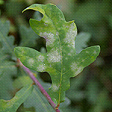
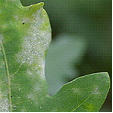 Quercus robur
Quercus robur
Quercus species are susceptible to several powdery mildew fungi including (Sphaerotheca lanestris), (Erysiph trina) and (Phyllactinia corylea). Generally white mealy growth appears on the leaves, normally on the underside turning the infected areas brown and then the leaf dies. The infection may spread to the twig tips causing dieback. Control may be difficult and unwarranted on large trees but nursery stock may be sprayed with a fungicide during susceptible periods.
Rosa species are also infected by the powdery mildew (Sphaerotheca pannosa).
Rudbeckia and Senecio species are covered in white fungus (Erysiphe cichoracearum) which infects leaves, flowers and stems. This results in the plant becoming stunted.
Senecio species are infected by the powdery mildew (Sphaerotheca fuliginea) which forms circular white powdery areas on the leaves.
Spiraea species are infected by the Powdery Mildew (Microsphaera alni) and (Podosphaera oxyacanthae).
Ulmus and Rhododendron (Azalea) species are also infected by (Microsphaera alni). Circular patches of white powdery growth appear on the leaves.
Veronica species are sometimes infected by the powdery mildew (Sphaerotheca humili) causing a white coating to appear on the leaves. Not normally a major problem.
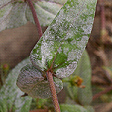
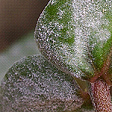
Zinnia elegans are commonly infected by the powdery mildew (Erysiphe cichororacearum), which appears on both sides of the leaves as a greyish powdery cover and may be transmitted by seed.
Non-chemical Control
Choose less susceptible species and when planting space the plants to allow good air circulation. Avoid overwatering and try to keep the foliage dry. Affected plants may be dusted with powdered sulphur or sprayed with a milk mixture to discourage mildew. Vegetables that are infected with mildew should be removed and replaced with new young plants, as they are more resistant to infection.
Chemical Control
Prenatitive spraying during warm humid conditions using a suitable fungicide such as wettable sulphur, bitertanol, carbendazim, fenarimol and triforine helps control the problem.
Note
Always read the label for registration details and direction of use prior to application of any chemicals.
DISEASE
NAME
Mosaic Virus
Various species
Description
This is a casual viral organism that affects the leaves of the host.
Symptoms
Some of the host plant leaves becomes mottled towards the leaf margins, or completely yellow giving a variegated or marbled appearance. The leaves may also become distorted or crinkled. Flowers are also affected showing signs of colour breaking by forming patterns on the petals.
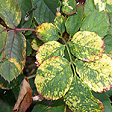
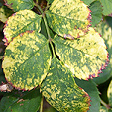 Rosa species
Rosa species
Rose Mosaic (Marmor rosae) causes intermittent irregular yellowish areas on the leaf surface of Rosa species. These chlorotic pattens tend to be along the mid rib but are also found along the margins.
Source and Dispersal
Propagation from infected plants will spread this disease. Certain species are also spread by insects such as thrips or aphids.
Favoured Conditions
There are no known favoured conditions but generally appears during the growing period.
Affected Plants
Many plants are infected by various Mosaic viruses such as Fragaria, species.
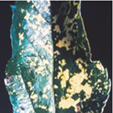 Apple Mosaic Virus
Apple Mosaic Virus
Camellia - particularly japonica and reticulata are infected by the Camellia Mosaic Virus. This virus is not thought to be transmitted by insects but through propagation methods such as grafting. The yellow mottled appearance on the leaves could also be attributed to genetic changes, as all affected leaves develop a simular pattern.
Delphinium, Limonium, Mathiola, Primula, Petunia and Cucumis species are infected by the Cucumber Mosaic Virus (Marmor cucumeris).
Laburnum anagyroides is infected by the Laburnum Vein Mosaic virus which causes vein banding on the leaves.
Orchids such as Cattleya, Cymbidium, Cypripedium, Dendrobium, Epidendrum, Oncidium, Paphiopedilum, Phalaenopsis and Zygopetalum species are infected by Cymbidium Mosaic Virus and Tobacco Mosaic. Cattleya and other orchid species exhibit leaf necrosis in the form of rings or streaks and necrotic sunken areas that are brown or black on the mature leaves.
Non-chemical Control
Remove and destroy contaminated leaves upon sight and take note that even if the plant appears to have only a little damage, the whole plant will be infected and replacing it is the only way to eliminate the problem.
Chemical Control
There is no chemical solution for viral infections.
Average Lowest Temperature : -1º C 30º F
USDA : 8, 9, 10, 11
This USDA (United States Department of Agriculture) hardiness zone chart can be used to indicate a plant’s ability to withstand average minimum temperatures. However, other factors such as soil type, pH, and moisture, drainage, humidity and exposure to sun and wind will also have a direct effect on your plant’s survival. Use this chart only as a guide, always keep the other factors in mind when deciding where, when and what to plant.
A plant's individual USDA zone can be found in the Plant Overview.
Region of origin
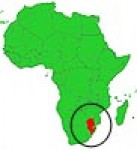
South Africa (Northern Province)
Climate Description
Warm to Sub-tropical
This overlaping zone has ample rain with high summer temeperatures and high humidity. Winters are mild. Pockets of sub-tropical climates exist within coastal warm temperate zones.
Frosts and droughts rarely occur along the coast.
Plant growth
Tropical and warm temperate native and exotic plants grow well.
| Dictionary | Growth Habit |
| Leaf Type | Botanic Flower Description |
| Leaf Shape | Flower Inflorescence |
| Leaf Arrangement | Fruit Type |
| Leaf Margin | Bark Type |
| Leaf Apex And Bases | Flower Description |